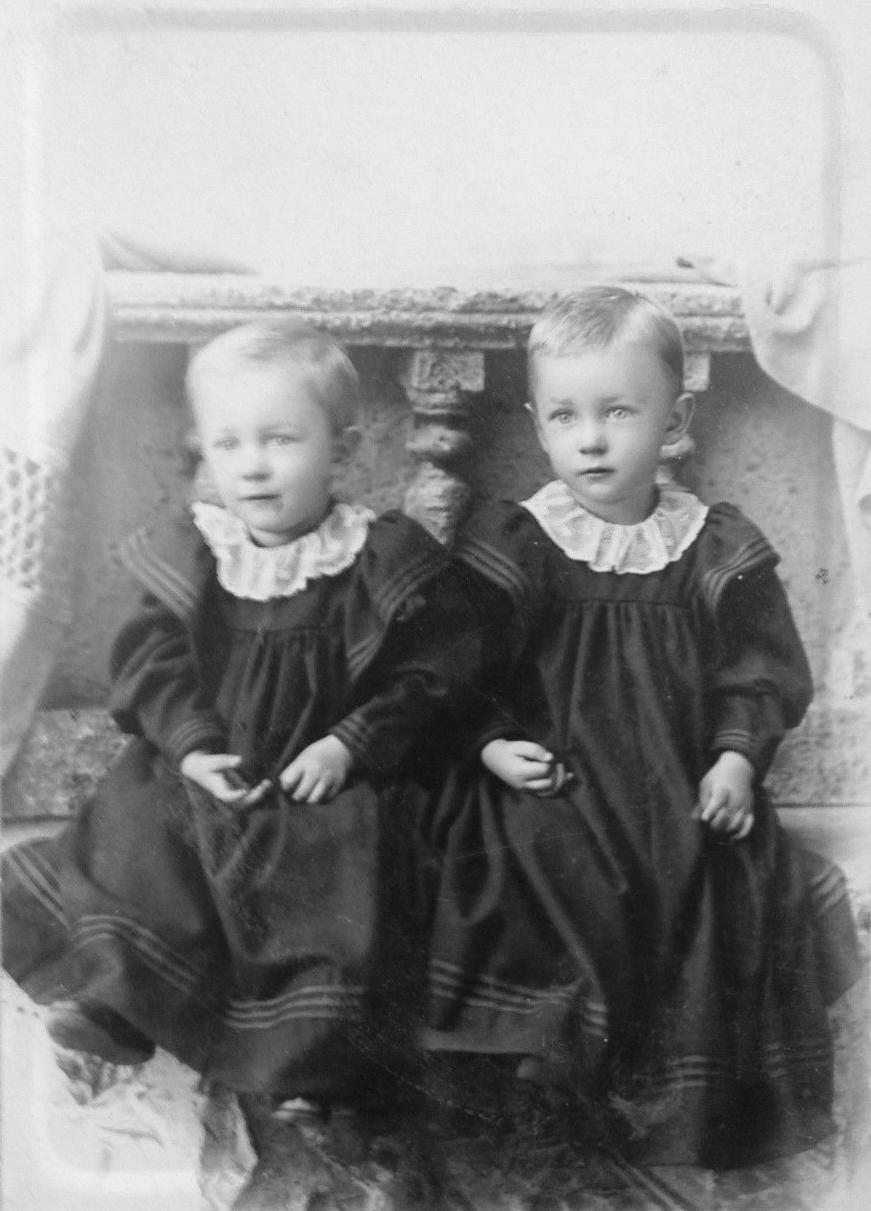
American Boy Skirted Garments: Chronology--The 1900s

Figure 1.-- This cabinet card portrait shows two boys identified on the back as 'Arthur and Archie- Fred's boys'.
We thought tghey might be twins bout 1-2 years old. A reader tells us, "When I look at the image, I see two children about a year apart. The boy on the right looks older than the boy on the left who appears to be being held from behind which we did with our daughter around that age." As they are brothers, I suspect that they would be at least 1 1/2 year apart. So that would probably mean something like 1-3 years of age, perhaps the older boy is not yet 3 year olds. They both wear identical dresses with frilly collars. Also note the short hair. The convention of dressing younger boys in dresses continued into the 1900s, but mostly for just very young boys. The portrait is jundated, but the mount style suggests the turn-of-the 20th century. We would say about 1900-05. The studio was the Gaites Gallery, Macomb Illinois.
|
|
"American boys still wore skirted garments in the early-20th century, but to a much more limited extent. The fashion for the most part had declined significantly, a trend which began kin the late-1890s. Especially after the early-1900s we see far fewer boys wearing dresses and kilt suits. And even in the eary-1900s, the boys we do see wearing skirted garments were just the very youngest boys. We no longer see many older pre-school boys wearing skirted garments like they did in the 19th century. We still see a few boys wearing dresses, but they tend to be very young boys. Rarely do we even see 3-year olds and virtually never 4-year olds wearing dresses. And the dresses were commonly plain, not the fancy dresses we might see in the 19th century. And we see far fewer skirts and kilts, especially by mid-decade. There was on exception to this declining use of skirted garments--the tunic suit. In fact, the tunic became a very popular boys' garment in both the 1900s and 10s. Tunics were worn throughout the 19th century, but had declined in the 1880s. At the turn-of-the 20th century, however, tunic suits became was a major style for boys. Some girls wore them are dresses styled rather like a tunic stuit, but they were much more popular for boys. The popularity of all other skirted garments, especially dresses and kilt suits, declined very sharply, especially after about 1905. This was the exact oposite for tunics. We see the shift in catalogs which were increasing in number, detail, and coverage and have the advantage of being dated. It is also very notable in the photographic record. We saw this decline notably beginning in the 1890s, but it was especially notable during the 1900s. We do not understand just why this shift in clothing conventiins occurred, but it it is very notable.
HBC

Navigate the Historic Boys' Clothing Web dress pages:
[Return to the Main U.S. skirted garments chronology 20th century page]
[Return to the Main U.S. skirted garments chronology page]
[Return to the Main U.S. skirted garments page]
[Return to the Main U.S. garment page]
[Pinafores]
[Ringlet curls]
[Smocks]
[Bodice kilts]
[Kilts]
[Fauntleroy dresses]
[Sailor dresses]
[Fancy dresses]
[Dresses: 16th-18th centuries]
[Dresses: Early-Mid-19th century]
[Dresses: Late-19th century]
[Dresses: Early 20th century]
[Difficult images]
[Movie dresses]
Navigate the Boys' Historical Clothing Web Site:
[Introduction]
[Activities]
[Biographies]
[Chronology]
[Clothing styles]
[Countries]
[Bibliographies]
[Contributions]
[Essays]
[FAQs]
[Glossaries]
[Images]
[Links]
[Registration]
[Tools]
[Boys' Clothing Home]
Created: 10:09 PM 10/16/2014
Last updated: 10:10 PM 10/16/2014



